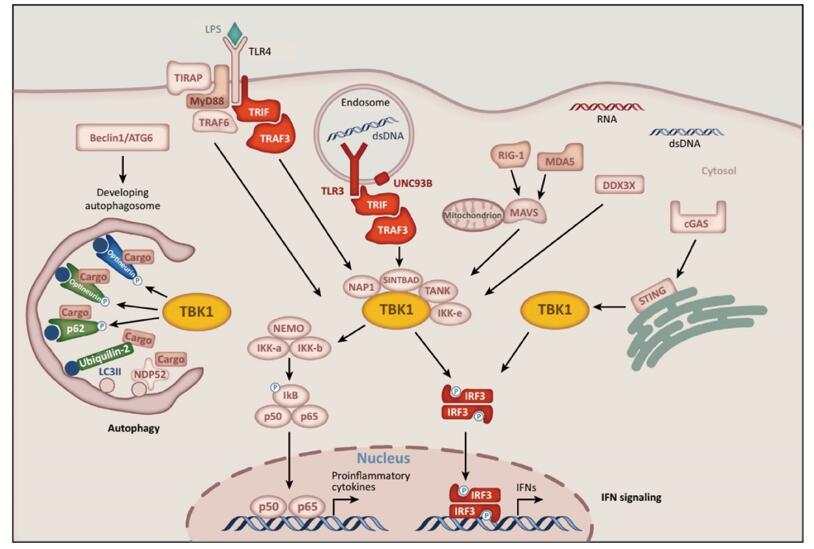
Our promise to you:
Guaranteed product quality, expert customer support.
 24x7 CUSTOMER SERVICE
24x7 CUSTOMER SERVICE
 CONTACT US TO ORDER
CONTACT US TO ORDER
TBK1 Gene Editing 
Tumor necrosis factor (TNF) receptor-associated factor NF-kB activator (TANK)-binding kinase 1 (TBK1), also known as NF-κB-activating kinase (NAK), has attracted the attention of human immunologists, geneticists, and neurologists alike for its important role in central nervous system (CNS) pathology. TBK1 is a member of the atypical IκB kinase (IKK) family, which also features another highly related family member IKKε. When DNA and RNA virus are infected, the Stimulator of Interferon Gene (STING) binds with TBK1 and promotes its phosphorylation on Ser172 within the TBK1 activation loop. This is necessary for its kinase activity to induce STING phosphorylation on Ser366 and the type I interferon response by directing IRF3 phosphorylation. Therefore, TBK1 is a required element of innate immune signaling in cells. In recent years, the role of TBK1 has been extended to cancers.
TBK1 Signaling Pathways
TBK1 is involved in the activation of various cellular pathways resulting in IFN and proinflammatory cytokine production after infection, autophagic degradation of protein aggregates or pathogens, and cell growth and proliferation. TBK1 was first identified as a TANK-interacting protein in mice, and played a role in controlling NFκB-mediated responses as demonstrated in luciferase reporter assays of HEK293T cells cotransfected with TBK1 and the NF-kB promoter. However, unlike the canonical IKKs (IKKα and IKKβ) that control NF-kB activation, the noncanonical IKKs (TBK1 and IKKε) have been found to play a more important role in the activation of transcription factors of the IFN-inducing IFN-regulatory factor (IRF) family. TBK1 has been shown to play a key role in many cellular pathways, particularly autophagy and inflammation. TBK1 sits at the crossroads of multiple pathways, including IRF3 and NF-kB, and controls multiple target genes, including type I and type III IFNs.
 Figure 1. TBK1 molecular pathways. (Ahmad L, et al., 2016)
Figure 1. TBK1 molecular pathways. (Ahmad L, et al., 2016)
Role of TBK1 in Diseases
The obvious role of TBK1 in immune response has highlighted its potential as a therapeutic target for autoimmune diseases. In addition to its role in the mediation of antiviral responses, TBK1 has also been proposed to be a target for inflammation, cancer and other diseases. More and more studies have demonstrated that TBK1 mediates cell apoptosis and proliferation in cancer cell lines, especially those that depend on oncogenic KRAS expression. It was shown that TBK1 plays an important role in maintaining drug resistance in prostate cancer (PCa) cells. TBK1 can interact with mammalian target of rapamycin and inhibit its function, thus inducing cell-cycle arrest in PCa cells. In certain cancers like breast, pancreatic, lung, and colon cancers, TBK1 is highly expressed and provides pro-survival signals. It is worth noting that the same kinase is involved in both antiviral immune response and oncogenic transformation. This may be due to the fact that TBK1 can act on different targets in different pathological environments.
In the case of autoimmune diseases, TBK1-mediated signaling contributes to the production of IFN-I, autoantibodies and chemokines. These molecules then initiate and amplify immune attack on tissues resulting in organ damage and disease. Autoimmune diseases such as multiple sclerosis and rheumatoid arthritis may also benefit from inhibiting TBK1-mediated immune signaling. One study highlighted the importance of the TLR3-TBK1 signaling pathway in FLS, resulting in IRF7 activation and CXCL10/IP-10 expression, which is closely related to the pathogenesis of rheumatoid arthritis. TBK1 also controls the migration of autoreactive T cells to the brain and participates in the pathogenesis of MS-like autoimmune manifestations. TBK1 also interacts with the master regulator of cellular metabolism, mTORC1, and inhibits its function. Therefore, it is speculated that TBK1 may play a broader role than previously thought, coordinating the crosstalk between immune response and metabolism.
TBK1 Gene Editing Services
CRISPR/Cas9 PlatformCB at Creative Biogene is dedicated to offering comprehensive CRISPR/Cas9 gene editing services and products for academic research, biotech research and pharmaceutical drug discovery. With deep gene editing knowledge and extensive experience in experimental operation and data processing, we help you effectively control TBK1 genes knockout/knockin/point mutation in cells or animals via CRISPR/Cas9 technology.
| Service | Details | Alternative cell lines or animal species |
| TBK1 Gene Editing Cell Line Generation | gRNA design and synthesis Transfect the cell lines you're interested Select the high expression cells and sort monoclonal cell Validate the knockout/knockin/point mutation of TBK1 by PCR and sequencing Provide cryogenically preserved vials of stable cells and final reports | HEK239T, Hela, HepG2, U87, Ba/F3, CHO, MDA-MB-453, MDA-MB-231NIH3T3, T47D, Neuro2a, MCF7, RKO, K562, RAW264.7, etc. |
| TBK1 Gene Editing Animal Model Generation | TBK1 gene conventional knockout animals TBK1 gene conditional knockout animals TBK1 point mutation animals TBK1 knockin animals | Mouse, rat, rabbit, zebrafish, C. elegans, etc. |
Related Products at CRISPR/Cas9 PlatformCB
References
- Ahmad L, et al. Human TBK1: a gatekeeper of neuroinflammation. Trends in molecular medicine, 2016, 22(6): 511-527.
- Bodewes I L A, et al. TBK1: a key regulator and potential treatment target for interferon positive Sjögren's syndrome, systemic lupus erythematosus and systemic sclerosis. Journal of autoimmunity, 2018, 91: 97-102.
- Yu T, et al. TBK1 inhibitors: a review of patent literature (2011–2014). Expert opinion on therapeutic patents, 2015, 25(12): 1385-1396.
- Hu L, et al. TBK1 is a synthetic lethal target in cancer with VHL loss. Cancer Discovery, 2020, 10(3): 460-475.
- Hasan M, Yan N. Therapeutic potential of targeting TBK1 in autoimmune diseases and interferonopathies. Pharmacological research, 2016, 111: 336-342.